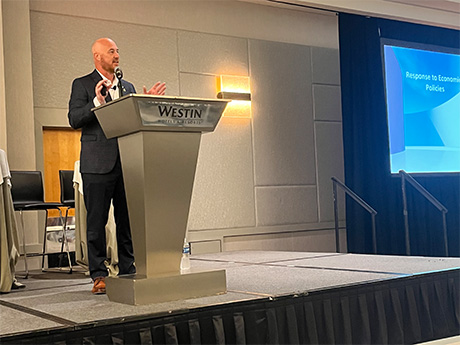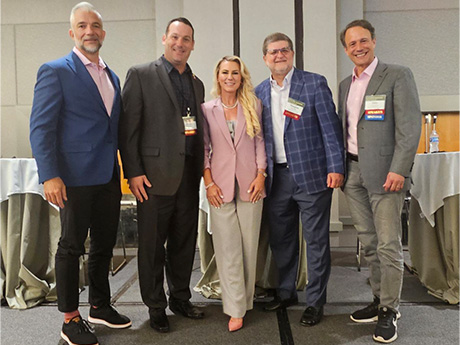ATLANTA — Seniors housing is a sector that has a long track record of carefully balancing care for its residents with the fundamentals of real estate, namely the return on investment in the form of monthly rental rates. Equity and debt partners have appreciated the sector as an investment vehicle for decades, but are now fully grasping how important operators are to realizing those gains.
This was the topic of discussion among the “power panel” of executives at InterFace Seniors Southeast, an annual conference that was held at Westin Buckhead Atlanta on Wednesday, Aug. 28, an event that attracted 358 seniors housing professionals. Panelists were asked by moderator John Lariccia, CEO and founder of WelcomeHome Software, to summarize the state of the seniors housing industry in a single word. Doug Schiffer, president and chief operating officer of Allegro Senior Living, selected “encouraged” as the best term to describe the current mood of the sector.
“The encouragement comes into the fact that both versions of capital, whether it was equity or debt, have actually recognized now the importance of the operator,” said Schiffer. “For quite some time, it was about the importance of the real estate and how the buildings were designed, and then ‘we’ll go find an operator later.’ There’s a resident focus now that is really important, so I’m encouraged.”
Jesse Marinko, CEO and founder of Phoenix Senior Living, said that “optimism” was his word to describe the industry. However, later in the panel he noted that seniors housing as a whole is coming to a head in terms of who’s going to be left holding the bag if rental rates get out of reach.
“The reality is that there is a good likelihood that assisted living and memory care rates over the next four to five years could almost be 50 percent higher than they are today,” said Marinko. “A family will lose its mind if it’s being asked to pay 8 to 10 percent more than they already are. There’s an inevitable crossroads that has to happen, but the only answer [right now] is to push rates because wages and the cost of construction aren’t going down.”
Collaboration is key
Another key change in the seniors housing industry is that operators are collaborating among themselves. For that reason and others, Sevy Petras, CEO and co-founder of Priority Life Care, chose “renaissance” as her word to describe the state of the industry.
“We’re looking at each other as comrades versus competitors,” said Petras. “That truly speaks to what is going to fuel the success and the excitement behind this next 10 to 20 years.”
Another form of collaboration is happening behind the scenes between owner-operators and Medicare by way of the Medicare Shared Savings Program. The program is a voluntary, value-based payment model that allows hospital systems and healthcare companies to form Accountable Care Organizations (ACOs) to provide care to their Medicare enrollees at a reduced cost.
The incentive is that those ACOs can participate in shared savings if they can reduce healthcare inputs like emergency room visits, thus they are seeking to partner with experienced seniors housing operators to help streamline care and costs.
“It’s an opportunity to provide care in our communities to keep [residents] out of the system,” said Chris Guay, founder and CEO of Vitality Living. “And then in theory, if we help create those savings, we can then participate in the shared savings.”
Guay added that seniors housing participating in the Medicare Shared Savings Program is about two to three years away from any meaningful traction, thus he emphasized that what is happening today at the property level is more important.
One industry hardship he noted is that there is significant burnout among clinicians in the higher acuity seniors housing settings.
“They are on call and are having to coordinate with a resident who has seven doctors who aren’t talking to each other,” said Guay. “We’re working with a group called Curana Health that will bring onsite nurse practitioners and medical support to work with our teams. That makes available positions on our staff more attractive and it’s helpful for our business.”
Balance business and care
During the conference’s keynote presentation, Bear Mahon, president and CEO of Oaks Senior Living, asked the audience why they were there. He identified three buckets that the audience could largely find themselves in: Main Street (i.e. operators), Wall Street (i.e. owners, equity partners, lenders and financial intermediaries) and industry partners (vendors).

Mahon said that identifying those three categories was important because they all work together to create value for the residents and their families. To achieve that, Mahon said it comes down to operators striking a healthy balance between the clinical care side of the business and the sales and marketing component.
“Our staffs have big hearts,” said Mahon. “Our job as partners is how to get their business IQ to match the size of their heart. The most important thing, and the reason that we are all in this business — or you should be — is because of care.”
Speakers at the power panel concurred. Guay, Petras and Marinko all mentioned during the course of the discussion that nothing can replace the human touch for residents and their families, who are ultimately the ones paying the bills and keeping the industry afloat.
Mahon said that now more than ever seniors housing is a real estate business that adheres to principles such as supply and demand. But sometimes what’s lost in the real estate business is that increases in operational costs cannot be fully passed on to the residents and their families, no matter how revolutionary the new technology is that’s being implemented.
“I think there’s an assumption that with new great technology that residents will just pay for it, but we’ve talked this whole panel about how our customers are very sensitive to costs,” said Guay during an open Q&A at the end of the power panel discussion.
“So vendors, please bring in a technology that helps us get a better outcomes, but also can fit into our pricing structures, because we just can’t add much to our residents,” he said. “The math won’t work for them and we can’t absorb it because how depressed our margins are.”
Guay also mentioned that one effective method to bridging that divide between vendors and operators is to partner in a risk-sharing model.
“Some partners were open to sharing risk with us and said that they’ll come in and do this at no cost to us or greatly discount the rates to prove the concept,” he said.
One aspect of the seniors housing care model that can sometimes get lost in the shuffle is the priority of the day-to-day care staff. Guay said that the COVID-19 pandemic taught the industry a valuable lesson in terms of its relationship with onsite care teams.
“COVID taught us a lot; we got caught with getting way behind wages and not really creating a value proposition for people who work in the business,” said Guay.
Lariccia said that about a decade ago he was looking at some empirical data and had an “aha” moment: employee satisfaction has a direct correlation with resident satisfaction, which has a direct correlation with occupancy. In other words, a happy care staff makes for a profitable seniors housing community.
“If your employees feel like it’s a great place to spend their time, the residents feel that it’s a home with a great staff and then the building sells itself,” said Lariccia.
“Frustration from our staff ultimately hurts our occupancy and margins,” added Petras. “The whole reason anybody works in a building is because they want to spend time with our residents. We have to finally give them the resources so they can just spend time with the residents and with each other.”
— John Nelson

